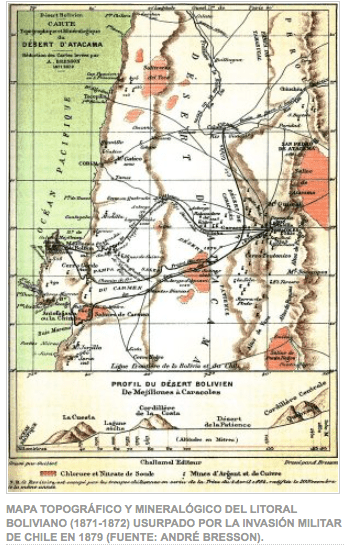El Diario brings us this needed information:
Historical background of the Bolivian Litoral
 Certain authorities of Chile supposed that by distorting the truth, they can eliminate the history of Bolivia. They say that Chile can not yield even a millimeter of their territory, they are right. Well, Bolivia never claimed that the neighboring country would grant us any space of its territory.
Certain authorities of Chile supposed that by distorting the truth, they can eliminate the history of Bolivia. They say that Chile can not yield even a millimeter of their territory, they are right. Well, Bolivia never claimed that the neighboring country would grant us any space of its territory.
In fact, Chile originally had a territory of modest dimensions, much less than a million square kilometers. It extended its geographical area arbitrarily occupying those that had no owners yet, as it did in Antarctica and seizing the Beagle, in the Strait of Magellan.
Its territorial appetite was insatiable. For this circumstance, invaded Bolivia, through a war of conquest in 1879, and took over its Litoral Department, through which had access to the Pacific Ocean along 400 kilometers of coastline.
TERRITORY
In total, with the total occupation of the department, Chile seized 120,000 square kilometers of Bolivian territory.
The demand of the country is to recover at least a portion of the territory usurped by Chile, to regain access to the sea, which is not the same as saying it intends to take something from their original territory to Chile.
There are also incontrovertible evidence that the Litoral Department belonged to the jurisdiction of Bolivia. Among them, of foreign nationals who came to the country.
Since the birth of Bolivia, in 1825, until the outbreak of the Pacific War, unleashed by Chile against Bolivia, in 1979, many French who exercised the function of diplomats, explorers and professionals and scientists, among others, recorded in reports, travel memories and drawings, their vision of mining and plant resources, as well as the situation in the Bolivian Litoral.
LITORAL COAST
One of those pioneers was Alcide D’Orbigny (1802-1857), who explored the territory of Bolivia between 1847-1849; Leonel Marie Angrad (1808-1886), consul and chargé d’affaires between 1847-1849, through drawings described cities located on the coast of the Litoral.
Colonel Felipe Bertres in the book he wrote about his exploratory experience, gives a description of the corresponding Bolivia sea coast, its lakes and navigable rivers, with an additional statistical; and exposes clearly the inheritance of the Bolivian littoral country.
Many years later, in 1870, another important engineer came to Bolivia, French traveler and explorer, André Bresson.
FIRST EXPLORATION
The Bolivian writer Manuel Frontaura Argandoña wrote that this character became the country concerned, it seems, in the juicy business that then became exploring railway projects and nitrate concessions in the west, and colonization. He was an engineer and ran almost the entire territory of Atacama before entering into Bolivia.
As their mark and results of his observations he published in 1886 a book entitled: “Sept annes déxploratios, de voyages et sujoures dans, Amerique Australe” with several illustrative drawings and maps of this Bolivian territory.
SECOND EXPLORATION
In a new exploration that he made of the place in 1872, he gave the following description of Antofagasta: “Today it is the main port of Bolivia, welcomes more than 10,000 people and has a church, a school, a hospital, a theater and a circus, and a club. All these buildings, like the houses are made of wood or corrugated galvanized; this may not be very architectural, but gives quite good looks, being a city on the border of two deserts. The loneliness ocean and land loneliness “.
ENCHANTED LANDSCAPES
At the conclusion of his work says: “Nowhere in the world’s most impressive spectacles that nature offers. It has gathered in Bolivia at most sublime mountains hide their peaks in heaven, lakes like oceans of freshwater, sound majestic waterfalls and rivers that meander in the lush jungles; shaded valleys where every turn leads to new places, more picturesque, huge rocks; definitely a lovely region, to the west Salvator¡’s loneliness, and to the east enchanted landscapes of Claude 3 “.
As the lie can not change the history of peoples, on this page El Diario reproduces the historical background and the loss of Bolivian Litoral, which were recorded in The Book of the Sea, published by the Foreign Ministry of the country in 2014.
